
Got some useful appointments in today. Our first visit was with a couple of guys at the São Paulo Secretariat of Energy – renewable energy. We were following up on a successful speaker visit and hoping to strengthen connections and contacts. Our Brazilian friends were more than eager to do this to our mutual benefit.
Brazil is a leader in various sorts of renewable energy and they have a lot to share, especially in areas like biogas, ethanol, biomass & biodiesel. Of course, the USA has a lot to share too in some of the same areas, but in addition in areas of storage and energy net coordination. Mutual sharing means mutual benefit, since more brains are better and when we solve problems in diverse ways, we learn more than if we just have a few options.
Brazil, like the USA, is a continental country. When talking about renewable power, this brings challenges and opportunity. Brazil has a lot of wind power potential, for example, but it is poorly distributed, with the best wind power sites in the less populated areas of the Northeast. Wind (and solar) are also inconsistent. They need some sort of backup.
Hydroelectric power has been one of the best backups. Energy can be brought on line (or taken off) easily. There are two developments that have been creating complications. One is that droughts have made hydropower less reliable, even has the capacity of hydropower is being reached. A related problem is how dams have changed. In the interests of protecting local ecology, new hydro projects tend to be “run of the river” rather than reservoir based. A run of the river system, as the name implies, depends on the water running through the river. River flow varies with the seasons and the weather and more importantly for power storage, it cannot be turned off and on. The river flows as it wants.
A possible solution is natural gas. São Paulo currently has no facilities to receive liquified natural gas, but there are three terminals in Brazil (Pecém, State of Ceará; Bahia LNG Regasification Terminal, Bay of All Saints, State of Bahia and Guanabara Bay, State of Rio de Janeiro). Brazil is potentially a big market for America LNG. We are currently the Brazil’s third largest source of LNG, with great potential for more. Natural gas is clean burning and gas fired plants can be turned on and off relatively easily. Most natural gas is currently not renewable. However, there is great potential for biogas, so building out a natural gas distribution network can transition seamlessly to carry biogas as that develops.
Another “storage” mechanism is the grid itself. A big grid means that power can be moved from places suffering shortages to those with surplus. The wind may be inconsistent locally, but over a large area it tends to even out. Couple that with a natural gas/hydro backup, and you have a fairly reliable “battery.”
Energy is something I have been interested in since I was in college. This discussion was especially interesting for me and it was a joy to take part. It was very easy to see in this an area of mutually benefit. There is something even for those interested only in short term profit, since American LNG will find a good market in Brazil in the short term. I am more interested in the exchange of ideas.
And I am constantly recalling what Thomas Jefferson said – “He who receives an idea from me, receives instruction himself without lessening mine; as he who lights his taper at mine, receives light without darkening me.” If it is not too disrespectful to add to Jefferson, that light travels in both directions.





Rue Santo Amaro





My Brazilian colleague told me that Rue Santo Amaro, the street in yesterday’s photos, was designated as the most consistently ugly street in all São Paulo, so it is not fair to show only that. Gives a bad impression of the city if people think that is typical. I think he has a point. He says that it was once a decent street, with trees and shops. But since it was designated as a major artery, they put bus lanes down the middle and widened the street to take away the trees, parking spaces & most of the sidewalks. W/o parking or pedestrians, most retail shops closed. This has now been exacerbated by construction on the metros and monorail.
My second picture is the goldfish pond at the consulate. Last three are leftovers from yesterday. In picture #3 you can see some of the newer high rise apartments just off the street. Next is the trunk of that giant rubber tree. The tree sends down aerial roots that make it into a massive trunk. Last if from Atlanta Airport. If you think you will miss our president too much on leaving the country, you can get a Trump chocolate bar.
PS – notice in the pictures that the pavement is damp. It did not rain for 40 days before I got to São Paulo and the day I arrived it was sunny and warm. Then it started to rain. There have been patches of not rain, but it has kept up. More is predicted for the next five days. I am delighted that the drought is over and maybe this needed rain will be good for the plant and fill up the reservoirs. But it might have worked out better for me if the sequence had been reversed, i.e. lots of rain until the day I arrived and then warm and sunny time for my visit. I will be here about 40 days, so it would have worked out the same, but noooo.
Protected: Back in Brazil July 30
My first day back in Brazil
My first day back in Brazil, as promised. It is a little confused, but I figure a plan will become clearer. I have “redacted some names and rewrote sections, since even among us friends I do not feel free to make private talks public. This is part of the raw material that I hope to spin into decent narrative by the time I am done in Brazil.
Started my first working day in São Paulo with a breakfast meeting sponsored by the Ling Institute. This event was to announce the winners of scholarships in law, engineering, journalism and business. The Institute was founded in 1995 as a way for the Ling family to show gratitude to Brazil, where they were able to live and thrive after leaving China in 1951. The family lived in Porto Alegre, where I met the sons and daughter back in 1985 or 86. I will put a link to the Institute in the comments. Suffice it to say that they do a lot of good and now have built up an alumni network that is making it better.
Weakness of Memory, Power of Persistence
It was not fair when I approached old acquaintances introduced myself “again.” We had just been acquaintances and that was more than 30 years ago. What are the chances they would remember a random old guy. I did not make an impression that lasted 30 years. The consulate in Porto Alegre the then my colleagues when we closed and moved to São Paulo did a good job of keeping the contact, however.
Spreading Ideas and Ideas Spreading Themselves
Among the people we met a couple very much interested in exchanges, representing top American universities in Brazil. We talked about the ideas as viruses meme, i.e. that like viruses, ideas exist only in human hosts. They are passed along person-to-person and they mutate and develop along the way. This makes it difficult to trace the lineage of an idea, since it almost never belongs completely to one person. The metaphor we use to describe lineage of ideas is just not apt. We tend to thing of it like a tree, with roots and then a trunk representing the “original” idea and then branches. In fact, it is more like a cloud, with changes moving in indefinite directions, cross pollinating, doubling back and tangling.
This is what makes exchanges so crucial. We cannot simply transfer ideas in a linear fashion. They work best when they develop in the seemingly chaotic and evolutionary way above. If a Brazilian student goes to the USA, he learns some things and contributes some things. Ideally, we have feedback loop that may last decades. We study the exchanges when people have only just returned. This is like studying the ground right after the crop has been planted. It may take years for useful and appropriate ideas to develop, and by then many have forgotten about the initial condition that stimulate them.
All this makes it hard to assess effectiveness, but since I want to do just that, we agreed to talk more and maybe think of some concrete examples that illustrate success and then work backwards to figure out how we know. Worth a try.
The Challenges of Democracy
The keynote speaker at the event was Professor Schuler, himself an example of the type of exchange that stimulates ideas. He went on a voluntary visitor program early in his career and credits it with giving him new insights. Since then, he has cross pollinated with American thinkers and institutions, learned from them and shared their ideas. His talk included references to big thinkers, from James Buchanan (public choice theory) to John Rawls (theory of justice).
Technology Changes Put Populism on Steroids
His talk concerned the challenges and prospects of democracy. Brazil has experienced some interesting developments in this recently, but the factors are worldwide, as we Americans know. Democracy does not always produce the outcomes we might like and populists who get elected by appealing to emotion are also outcomes of democracy, not aberrations, features, not bugs.
Democracy has become a little more exciting recently for a couple of related technical and social developments. Social media has stripped away many barriers to information flow. We all have access to too much information, so we seek short cuts. This was once found in institutions. People looked to experts, statesmen, journalists, religious figures … Many of these institutions are now weakened or even gone. We might welcome the weakening of gatekeepers, but the result has not been more deep thinking by ordinary people but rather more emotion. People have stronger belief in their right to express their opinions and more means to do it. And there are new shortcuts in the form of identity politics.
Not What You Think but Who You Are
In the case of identity politics, thinking is rather discouraged, since you are supposed to think for the point of view of whatever your identity is. Other members of the group my not take kindly to heterodox thought and may consider you a traitor or a fool for even entertaining thoughts associated with the “other.”
So we have too much information, weakened mitigating institutions and strengthened capacity for people to speak out and complain, as well as greater incentive to be unreasonable in defense of their peculiar group interests.
I was hoping for some resolution for this problem, but none was forthcoming, except that Mr. Schuler talked a little about values that are essentially outside democracy. Rights and liberties are not – should not be put up to majority vote. If the majority decides to rob and beat the minority, the will of the majority does not make it legitimate.
I am not 100% sure I got it right, both because of my own bias and the fact that he was speaking in Portuguese (mine is rusty) but I think it was supporting my oft-repeated plea that we should draw a bright line between the personal and the political, because only with real pluralism of thought can we maintain a democracy is the face of such divergent and passionate thoughts. I will see if I can talk to him about that. Something to think about anyway.
Democracy Ancient & Modern
The speaker did not mention it, but I thought of Athenian democracy. We look back at that age with great fondness, but it reads better than it was lived. In fact, Athenian democracy was unstable and bellicose. Those who lived with it – including Plato, Socrates and Thucydides – viewed it with less enthusiasm than we do. In fact, the experience of the Athenians put people off democracy for the next 2000 years. It is one reason why the Founders chose to build our republic on a mixed constitution with roots more clearly in Sparta, the works of Aristotle or Rome, none of which called themselves a democracy and featured mitigating institutions to slow things down and cool passion. The legitimacy of any state ultimately depends on the consent to the people, but not on the ephemeral whims of the most vocal.
Lots of Thoughts in the First Couple Hours
I think this initial dive has given me some more idea that I will need to work out about exchanges, even if the ideas strayed a bit. During the rest of the day, I talked with the local staff. They are the biggest resource, since they know what contacts and exchanges we made and what came of them. There are decades of experience and the useful thing is that it is relatively easy to harvest. So far, interesting.
This is what I am leaving in Brazil (work at least)
Below is a description of what my colleagues are doing. You can see why I will miss it, even if it will be great to be back home and at Smithsonian.
Millions of Brazilians, who entered the middle class in recent decades and today constitute a majority, are demanding improved educational opportunities, enhanced international connections and development of essential skills, such as English competency. Brazilians know that the U.S. is a key partner in these priorities, and there is an element of urgency. The young Brazilian population is in rapid demographic transition. Fertility below replacement level provides space to improve education and social standards but Brazilians must develop new skills during a “demographic sweet spot,” when fewer dependent children are yet to be offset by more dependent seniors.
Much beyond that is also on fast-forward. Internet is creating new communications channels and fostering a boom in distance learning. We see the complex nature of the development, as social media is powering protests as well as education. Post has made impressive gains in social media through dedicated engagement. Our Mission Facebook page now has more than 400,000 fans and has recently been growing by more than 10,000 fans a week. While we don’t expect growth to continue at this torrid pace, adult literacy is improving, expanding the universe of readers and making Brazil a nation of Internet consumers, so we expect robust advance.
Education, English and youth outreach dominate our programming. PA encourages Brazilians to study in the U.S. in support of President Obama’s 100,000 strong for the Americas as well the Brazilian Science Mobility Program (AKA Science without Borders, see below). We nurture sustainable institutional linkages mostly in but not limited to education. The Smithsonian’s long-term cooperation agreements with Brazilian counterparts are being implemented and will facilitate myriad partnerships. Post fostered similar partnerships in English language and distance learning.
Our youth outreach programs include a robust Youth Ambassador Program, which regularly garners more than 12,000 applicants for the fifty spots, a Youth Council with representatives from every Brazilian state and specific programs, such as girls science camp and English immersion programs, as well as electronic and social media programs targeted to youth.
Despite recent progress and muscular effort, Brazilian authorities understand that English competence remains the big obstacle to greater Brazilian involvement with the U.S. and the world. Post is addressing this through our network of thirty–eight BNCs as well as Access programs that reach hundreds of students (with retention rates consistently above 90%) and programs targeted to underserved communities. We are continuing our partnership with the Ministry of Education (MEC) on “English w/o Borders, a massive effort to improve Brazilian English. We have placed a senior English Language Fellow in the Ministry who is helping implement this massive program. 120 English teaching assistants, recruited by us and paid for by GOB are deployed at Federal Universities. In 2013, 1080 Brazilian secondary English teachers took six-week courses at U.S. universities in a cooperative Mission/MEC program. Only 540 are travelling this year, due to World Cup and election complications but the program is slated to return to 1080 in 2015, up from only 20 in 2011. MEC expects to reach 7 million Brazilian students, many through distance learning, another fertile area of Mission cooperation.
U.S.-Brazil education landscape was transformed after the Brazilian President’s July 2011 announcement of the Science Mobility Program to send 101,000 Brazilian students overseas in the STEM fields. The U.S. got there first with the most and remains by far the largest recipient. More than 26,000 Brazilians have gone to the U.S. on the program so far. For comparison, in 2011 there were fewer than 9000 Brazilians studying in the U.S. in total of all programs. National efforts have been supplemented by local and state initiative, such as Brasília without Borders, which will also send thousands of students to the U.S.
Earlier success of our priority to connect U.S. and Brazilian education networks means that education initiatives are self-catalyzing at a significantly higher level. We are consolidating our gains. Education remains our top priority, but we are pivoting back to more traditional public diplomacy events and broadening our educational focus to include more on community colleges and lifelong learning. We also plan to devote more time to promoting social inclusion and a more expansive vision of Brazilian society by finding common aspirations and fostering links among cultural institutions, such as museums, and through sports.
Reaching underserved populations is a key priority that suffuses all PD programs, specifically through JAPER, support for favela pacification and women’s empowerment. Brazil is, and perceives itself as, a leader in sustainable development and clean energy; post remains active with outreach and exchanges to connect Brazilian and U.S. environmental communities.
Brazil has become a major venue for international mega-events, hosting the World Cup 2014 and Olympics in 2016, even as infrastructure lags to sustain Brazil’s status as major destination. In fact, infrastructure deficiencies – physical, human and institutional remain a general drag. PD programs have addressed these issues of Brazilian concern, especially through the VV and IVLP programs. Other major themes for visitor and speaker programs include environmental protection, security and economic integration.
A Brazilian economic slowdown is a caveat. We shared Brazilian aspirations and our division of labor was often our expertise and their money. Our enviable challenge was to manage unprecedented flows of mostly Brazilian resources. We are not sure this happy circumstance will continue in tighter times.
PA Brazil’s problem is too many excellent opportunities. We prioritize those that involve full partnerships with Brazilian institutions and government, use our unique expertise and flexibility, and provide significant leverage to produce outstanding results.
Good bye to Brasilia & all that
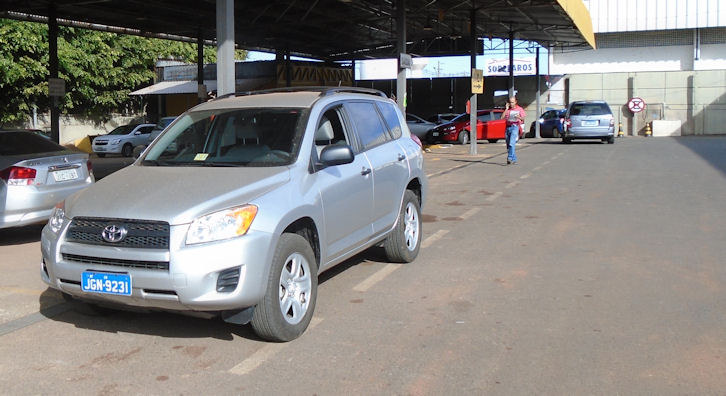
I have less than a week left here, so almost everything I do is “for the last time.” I sold my old car, pictured above. It had only 7,000 miles, most of those put on during a few long trips. But it is better to sell it here in Brazil than to take it home.
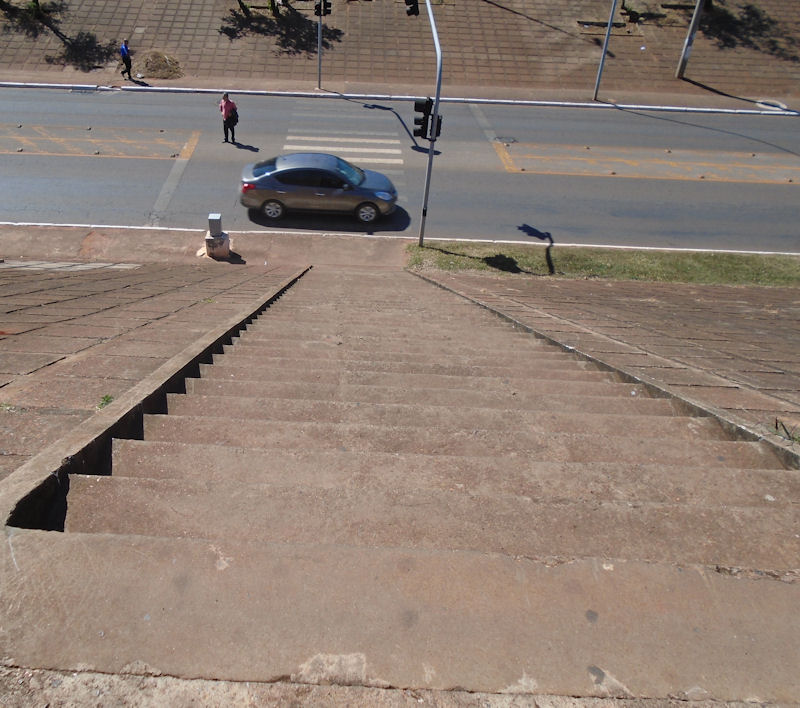
I went to the dentist for the last time. Dentists are a good deal in Brazil. They charge less, work faster and don’t give you a lot of trouble. I found that I could walk to the dentist office in reasonable safety. It takes only around 35 minutes. I don’t have a car anymore anyway, but even if I did, I prefer to walk whenever practical. You don’t always have a sidewalk and there are sometimes some steep walks, as you see above.
Brasilia is also changing quickly. The old planned city is still around, but it is being replaced by newer and usually better features. They are building lots of bike trails and pedestrian crossings. If the original planners didn’t dislike pedestrians, they sure didn’t do anything to make their lives safer or more pleasant. Brasilia’s current leaders are making up for some of this.
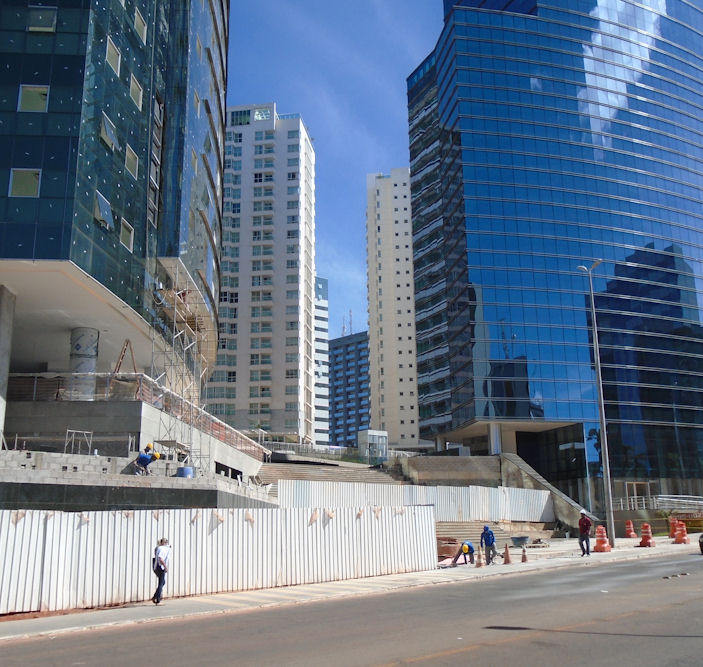
Last visit to São Paulo

Let’s call it a victory tour. I have been so extraordinarily lucky in Brazil, with opportunities opening and good people to work with, that I developed a kind of unreasonable dread that something would go wrong in the last few months and reveal me as only that little man behind the great wizard of Oz. “Pay no attention to the man behind the curtain.” With only days left, I think that I can declare victory, as nothing short of a catastrophe can prevent me from successfully completing the course.
As I wrote before, I am visiting my posts to say goodbye and thank you to the people who did the real work to make these years the success they have been. Today I am in São Paulo. I like São Paulo a lot. It has everything. You often hear bad things about the city and it is truly crowded and the traffic can be horrible, but it is also a very green city when you get to the human level. There are a surprising number of trees. True that many don’t have enough room to grow, but grow they do.
The people in São Paulo sometimes think of themselves as a country and in many respects they are not wrong. The São Paulo district, which includes São Paulo, Paraná, Santa Catarina, Rio Grande do Sul and Mato Grosso do Sul, produces about half of Brazil’s GDP. São Paulo state alone produces about 1/3. It has the best universities and the big newspapers. That is why I have been to São Paulo so many times, that and I like to stay at the Renaissance-Marriott. But as public affairs officer for all of Brazil, I had to be careful not to be beguiled by São Paulo. You could spend all your time working in São Paulo and never run out of excellent projects and valuable things to do, but Brazil is a bigger country than that. I always remind myself that having priorities means not doing many things that are good and so much of my challenge was making sure I did LESS with São Paulo lest I become too fond of it. Well, I am done with all that anyway.
That is one of the reasons they built Brasília. São Paulo and Rio were just too attractive and they wanted to pull people and attention to the rest of Brazil. Actually, in the “old” Brazil they had three states that really counted plus one associate member. São Paulo and Minas used to trade power between them. They called it café com leite, or coffee with milk, since São Paulo was the big producer of coffee and Minas was a dairy state. Rio was important because the capital was there and Rio Grande do Sul with its peculiar characteristics and ambitions was off to the side, but still a power-player. These places are all still the most important parts of the country, but w/o the old predominance. It is the story about the rise of the rest and moving the capital to the interior really helped.
This may have been my last ever time in São Paulo. I liked it better each time I visited the city. This is a post from one of my walks through the city on a quiet morning and another from the newer part of the city. And my more recent walk. My picture up top is from my hotel room.
I flew back to Brasilia on Gol. Usually I take Tam. Gol is a nicer. There is a lot more room.
Getting to know the neighborhood
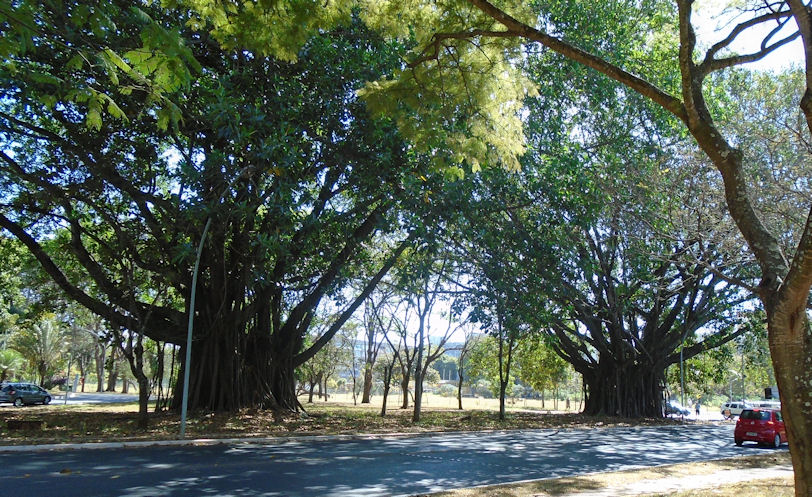
India rubber trees get really big around here. You really cannot tell where the truck stops, since “roots” drop down from the branches and add to the girth. These trees do give latex, but they are not the rubber trees where we get rubber that is the Pará rubber tree, a completely different species. You can see from the pictures how impressive they get. Recall that none of these trees are more than sixty years old, since that is when they built the city.
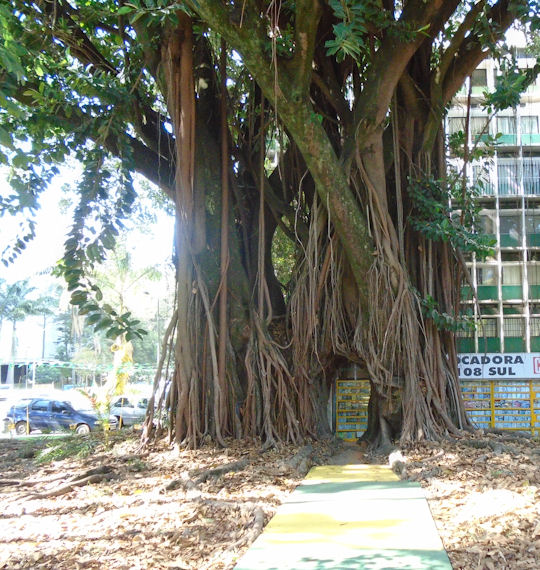
I have been looking for a good place to get my weekend meals. Maybe my criteria are not common. The place cannot be TOO close. I want to walk at least twenty minutes to get there, so that disqualified the nearby ones. I think I have found one in section 107. You can see in the picture. It has lots of salads plus churrasco.

The people of Brasília have done a good job of modifying their city to make it more pedestrian and bike friendly. It was designed as a car city, the vision of the future of 1960 and it still suffers from that original design. But it is getting better.

Rio, one last time with feeling
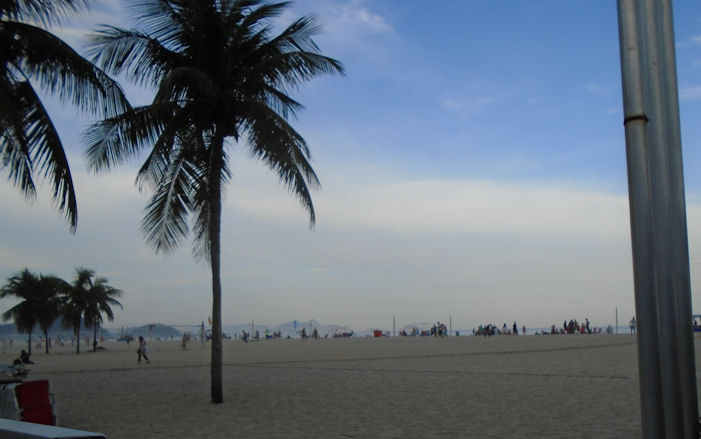
I am on the farewell tour of my posts. I am in Rio today. I will be in São Paulo next week and Recife the week after that. There is nothing left for me to do but say goodbye and to thank my good colleagues for all they did.
I am at the Marriott at Copacabana. It is really a great place, right across from the beach. I am not very much attracted to the beach, per-se, but I do like to go to the little cabanas and drink draft beer while watching the waves. Copacabana is interesting sociologically. During the sixties, it was a magnet for the young and the beautiful. Many never left. They are not as beautiful and young only in comparison to the sand and trees. Actually, it is likely that most of the coconut palms are younger. But I think it is a good thing. They seem content. There will probably soon be a generational change with new young people starting the cycle again.
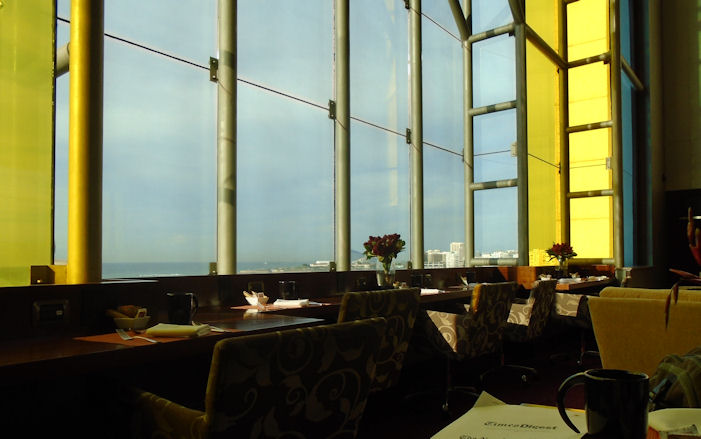
The taxi driver on my way to the consulate was a real Rio lover. He seemed a little gruff until I opened my window, explaining that I wanted to feel more of Rio. He told me as much as he could get in about the history of the city and why it is the greatest place in the world. The Paris of the tropics, he called it, but better than the Paris of France because God has sculpted nature to enhance Rio. He has a point about that. Rio is one of the world’s most beautiful natural locations for a city.
One of the big advantages of the Marriott, besides the location, is that I get free caipirinhas. I was a little unhappy when I noticed that I did not have my return flight to Brasília until 8:20. But now I am happy. I had time to go to the beer place near the beach & Marriott gave me a special pass to come back to the lounge, nice of them.
I am experiencing one of those moments in time where everything comes together. This happens not very often when the single moment seems to merge with the eternal. I cannot explain it and won’t try, but it is really a beautiful, peaceful and balanced feeling. It seems like nothing could cause me distress. It will pass when I have to get running to the airport, if not before, but I will enjoy it as long as it abides. I may never get back here and I want to remember Rio in this pleasant mood.
My picture up top shows the view from the little bar on the beach where I had my last Rio beer. The next picture shows the Marriott lounge, where I had my last Rio caipirinha. You can see why it is not hard to be in a good mood.
My temporary place
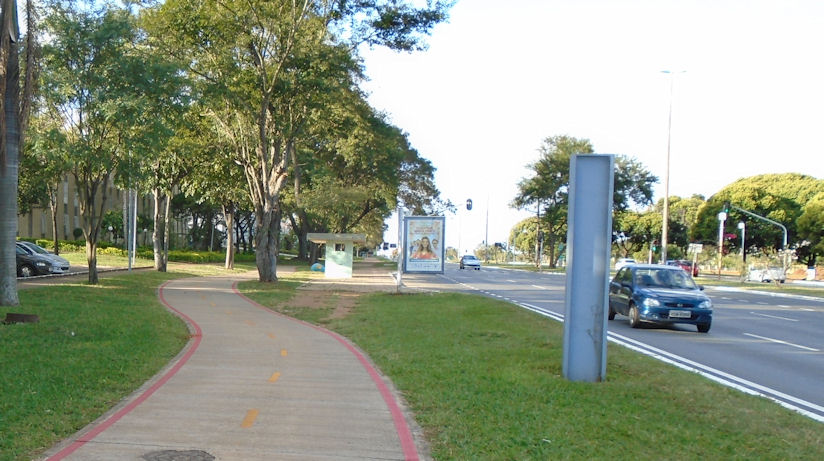
I have moved into temporary quarters in anticipation of my final leaving. The place is okay, although I liked my old place better and would not have moved had I not been asked. The commute is better. I don’t have to run across a busy highway. A bike trail follows the main road, see above. There is a tunnel under the big road here. You can see it below. It kind of smells, you might call it a pee-tunnel, but certainly better than running for it across the busy highway. After that, I can take side roads w/o much traffic. It is just a little farther than the other ride. It has some nice views, as you can see from my pictures a little farther down.

The neighborhood is good here. There is a supermarket within easy walking distance and lots of restaurants. What I miss is that there is no backyard. I like to go outside. Of course, I can do that here, but I don’t have a private nice place like I had.
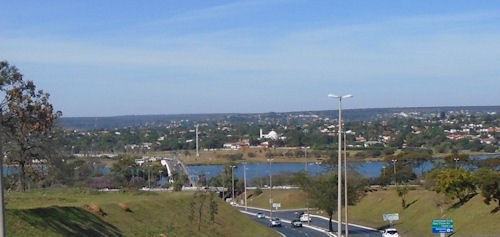
I lived in this part of Brasília when I was first assigned way back in 1985. It has changed for the better. Trees have grown much bigger; grass has covered most of the red dirt, eliminating much of the dust. And lots of good restaurants have opened. There is a significant micro-climate difference between here and my place on the other side of the lake. It is drier here and a little cooler. The wind blowing over the lake keeps the other side, at least the peninsula were I used to live, more humid and a warmer. I was always a little surprised when I walked down to the lake in the evenings and it was warmer. I grew up next to Lake Michigan and it was not warmer near the water.
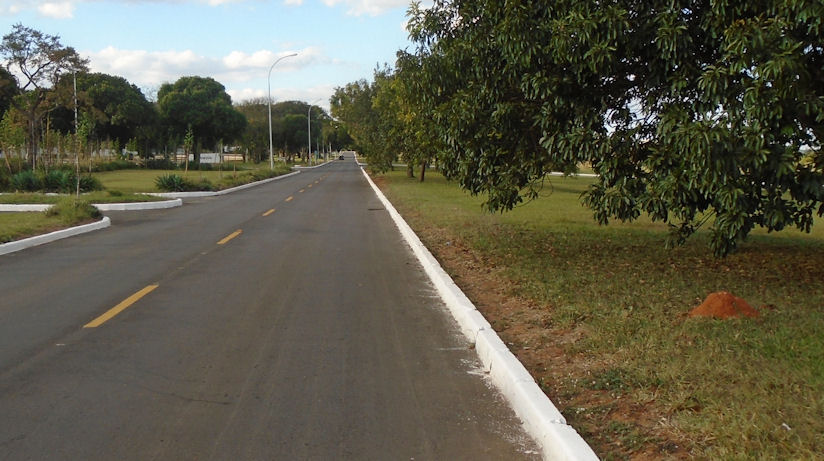
It is so strange to be almost done in Brazil. I had big plans. Things did not happen as I planned, but I am happy to say they turned out much better. I have always been lucky in my career; I have arrived at posts just before some big opportunity and always found great people to help me. But never before have I arrived to something as big as Science w/o Borders and all the programs that grew from it like English w/o Borders. This will influence U.S.-Brazil relations for a generation, not to mention improve education for tens of thousands of young people and improve science cooperation. This is probably my last overseas assignment and it is good to go out on such a high note. I don’t think it would have been possible to do better. I think I made the finish worthy of the start in Brazil and my next job is a dream. Lucky.
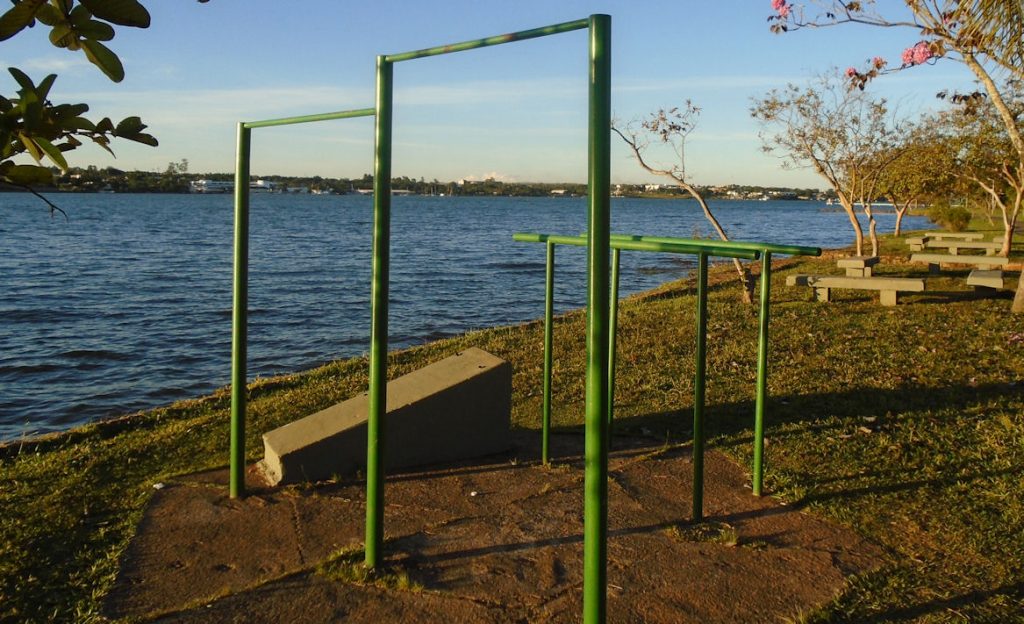
But I still have not found a chin-up bar equal to the one I left behind, above. This was the world’s best chin-up bar, exactly the right height for me, with a nice view and not many people around.
